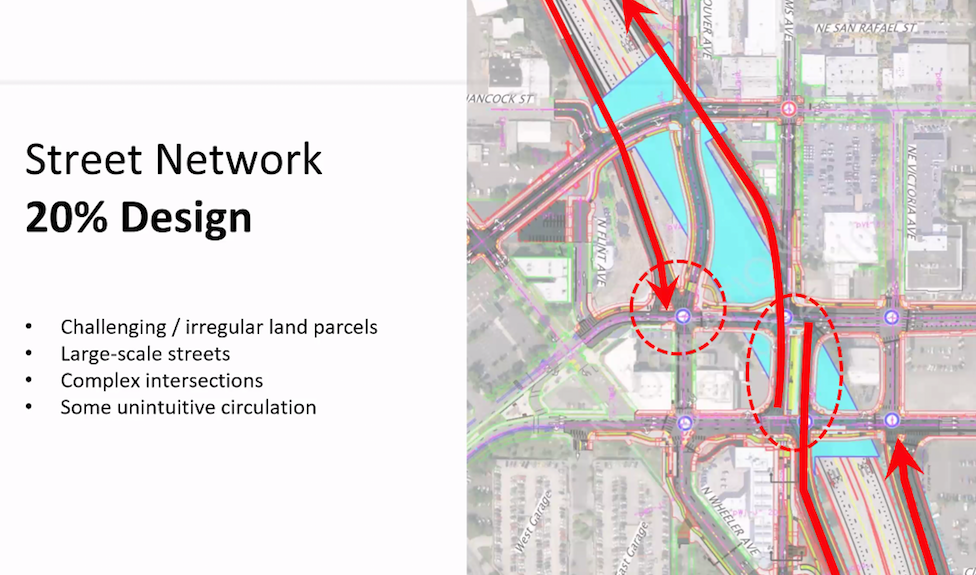The $800 million project transitions from “nothing has been decided” to “nothing can be changed”
There’s a kind of calculated phase-shift in the way transportation department’s talk about major projects. For a long, long time, they’ll respond to any challenges or questions by claiming that “nothing has been decided” or that a project is still being designed, that its in its infancy, and that objections will be dealt with . . . at some point in the indefinite future.
But then, a magic moment occurs, with no notice or observable event, and they’ll suddenly proclaim that it’s too late to raise and questions or consider any changes.
That’s exactly what’s happened with the Oregon Department of Transportation’s $800 million I-5 Rose Quarter project in the past few weeks.
You’ve got concerns? Not to worry, nothing’s been decided
As recently as last fall, ODOT’s Director of Urban Mobility, Brendan Finn was telling OPB’s Think Out Loud host Dave Miller, the project is only 15 percent designed, and that there was lots of opportunity for the community to shape the project:
Well, the project is still pretty much in its infancy, it’s only being at 15 percent design. I don’t clearly remember the exact verbiage as far as that. The House Bill that was passed that created the Rose Quarter project, HB 2017, did have certain parameters in it that were expected from the Legislature, and that was one of them. That said, there is almost an amazing opportunity here to connect neighborhoods and to provide not only multi-modal options, but community connections. And for us, making this move right now is signaling to the community . . . especially . . . those who have left the process, that we are willing to do things differently, we are ready to change, we are ready to be deliberative about our commitment to our shared values around restorative justice.
And very publicly at that time, ODOT convened an “Historic Albina Advisory Board “(after blowing up two other efforts at community engagement) and spent several million dollars hiring a team of consultants to conduct an independent highway cover assessment. ODOT hired a multi-million dollar team of consultants to undertake an independent analysis of the freeway covers, undertaking both a technical analysis, and seeking public opinion. This work developed a series of alternatives that vary considerably from the proposal being designed by ODOT—devoting more space to housing and better reconnecting the urban street grid, and moving freeway on and off ramps away from the center of project.

This process is proceeding according to the timeline ODOT announced when it appointed this new board last year. In May, consultants presented their analysis and recommendations to the Historic Albina Advisory Board and the project’s steering committee. Their alternatives, included two that rate much higher technically, and in community support, and which would significantly re-design the project.
Sorry, time’s up: Too late to make any changes
Now, ODOT says, it’s simply too late to think about doing anything different than what the agency first planned.
The community has been pushing for buildable covers for years, and now ODOT says, that any consideration of covers will create unacceptable further delays. Last week, in response to support by Oregon’s two Senators and local Congressman for buildable covers, ODOT said it was basically too late to think about doing that, according to the Portland Mercury:
A spokesperson for ODOT told the Mercury that while getting the cost of the caps fully funded by federal dollars would be “a dream,” there are still other obstacles to consider when building more substantial freeway caps. In order to build caps capable of supporting five-story buildings, the caps would need larger support pillars on either side of the freeway to ensure that there is enough structural strength to support the buildings.
“That could mean further acquisitions of land in the area, potentially displacing businesses,” said April deLeon, an ODOT spokesperson.
According to deLeon, changing the design of the caps now could also add time delays. The Federal Highway Administration would need to approve the new cap design, but would be under no timeline to do so. That time delay could make the project more expensive due to the cost of inflation.
It’s also worth noting that ODOT’s own consultants have said that buildable covers would be much more economical, if only ODOT would narrow the overly wide project to just the two additional lanes it says it needs, and built shoulders comparable to other urban freeway projects. According to ODOT, it will build stronger covers only if it gets to condemn other people’s land, not if it has to give up any of the monstrously oversized roadway it intends to built (and then to re-stripe into a ten-lane freeway).
ODOT’s reflexive claim that its too late, and too costly to even consider buildable caps shows that their claims of interest in “restorative justice” are just a sham. What the really want to do is build a wider freeway, and they’ll engage in whatever performative theatre they think is needed to convince people they care
Kudos to OPB’s Dave Miller for asking hard questions last fall: But what the media generally fails to do is follow the thread and insist on accountability. At what point did the project go from “infancy” to unchangeable? Who made that decision? Deus ex machina is a great literary device, but it’s no way to run a government.

